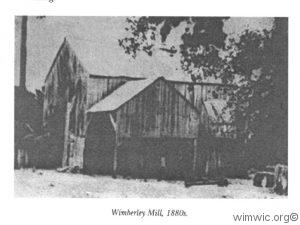First Came the Mill
 Wimberley started as a trading post settlement near Cypress Creek in 1848, the year Hays County was organized. After William Carvin Winters built a gristmill at the site in 1856, it took on the name “Winters’ Mill”. After Winters’ death in 1864, successive resident millers were his son-in-law, John Cude, and in 1874, Pleasant Wimberley, whose successful management lasted over 20 years. The last miller was John Will Pyland, who married Pleasant’s granddaughter, Susie Wimberley. Over the years, the mill was expanded to process lumber, shingles, flour, molasses, and cotton. The miller and his mill represented the anchor of Wimberley’s economic origin. The mill is gone, but the Winters-Wimberley house survives.
Wimberley started as a trading post settlement near Cypress Creek in 1848, the year Hays County was organized. After William Carvin Winters built a gristmill at the site in 1856, it took on the name “Winters’ Mill”. After Winters’ death in 1864, successive resident millers were his son-in-law, John Cude, and in 1874, Pleasant Wimberley, whose successful management lasted over 20 years. The last miller was John Will Pyland, who married Pleasant’s granddaughter, Susie Wimberley. Over the years, the mill was expanded to process lumber, shingles, flour, molasses, and cotton. The miller and his mill represented the anchor of Wimberley’s economic origin. The mill is gone, but the Winters-Wimberley house survives.
Remnants of a 3,700-foot long millrace, thought to date to the 1860s, still remains. The millrace was designated a State Archeological Landmark in 1989.
The Winters–Wimberley House

The village’s oldest documented stone house, the Winters-Wimberley House provided a home for both Winters and future millers. Winters chose a home site on a limestone promontory that rose high above the creek within view of the mill below. It is a simple, though substantial, rectangular limestone dwelling with a near-symmetrical, 3-bay primary facade. Winters probably built several small auxiliary structures near the house soon after its construction. As business increased, a wagon path soon developed between the trading post and the mill. Passing between the house and the creek below, the path eventually became part of the county road system. Ranch Road 12.
The original two-room section of the house is built of random, 18″ thick ashlar limestone blocks cemented with lime-based mortar. Stone footings provide a base for the masonry walls while the interior floor and walls are supported by pier and beam foundation.
Descendants of Pleasant Wimberley lived here until 1997 when the stone house, its later additions and surrounding five acres were purchased for community use.
In June 1998, Jeffrey H. Kester & Associates of San Marcos, Texas developed a Master Plan for the restoration of the Winters-Wimberley House. It was prepared for the Wimberley Institute of Cultures in conjunction with the Wimberley Senior Citizens Activities, Inc. and funded in part by a grant from the National Trust.
It was listed on the National Register of Historic Places in 2002 and now serves as the Wimberley Valley Museum.
WIC’s Involvement
In keeping with our concern for local history, WIC played a major role in the Senior Citizens Activities, Inc.’s acquisition of the Winters-Wimberley house. WIC undertook the responsibility of restoring the house and its usage. Phase I, focused on the rock portion of the house, was completed in 1998. Phase II, included later additions. Another important WIC involvement with historic preservation was the research and preparation of documents to nominate the Winters-Wimberley house to the National Register of Historic Places and as State Archeological and Historic Landmarks. These listings, which can be thought of as historic honor rolls, are carefully reviewed at both the state and national level. The Winters-Wimberley house has been awarded both National and State markers thanks to the hard work and dedication of WIC members.
William Carvin Winters
In 1835 at the age of 26 with his wife Lavinia and two children, Tennessee born William Carvin Winters relocated to Texas in 1835 with his parents, along with other siblings. The family originally settled in what is now Montgomery County. In that same year, William C. Winters received title to one league of land in Vehlein’s Colony situated in the present county of San Jacinto. On February 1, 1838, he received a certificate for one labor (177 acres) of land from the Board of Land Commissioners of Montgomery County.
William and two of his brothers fought at San Jacinto during the Texas Revolution and received 640 acres of land for having participated in the battle. Shot in the knee during the same battle, on January 24, 1861, he received a league (4, 428 acres) of land for having been wounded. He received an additional 320 acres of land for his service in the army.
Due to health concerns, in approximately 1856, Winters, his wife, and their children moved to the Texas hills close to the headwaters of the Blanco. According to J.W. Crouch of San Antonio, he “built a water grist mill and sawmill; made plows, hoes, and wagons for farmers, spinning wheels and looms for the homes, also chairs, bedsteads, and candles; made and brazed cowbells; made common nails and household utensils.” A bed that he made is part of the collection of pioneer furniture at the Washington-on-the-Brazos Historic Site.
Winters died in what is now Wimberley in 1864.
Pleasant Wimberley

Pleasant Wimberley was born in Wake County, North Carolina, on May 2, 1823. Leaving NC in 1843 with several of his siblings, they headed toward Texas, spending a few years before arriving there in Mississippi and Arkansas. On Christmas Day in 1847, they arrived in Brenham, Texas, where he met Amanda Jackson, and subsequently married her in the first month of 1849. Like most families of that era, their family grew from two to a total of twelve.
While living in Brenham the family obtained a large herd of longhorn cattle, and seven years after Pleasant married Amanda they drove the cattle north to a ranch on Walnut Creek on the Blanco-Llano county line, living in the area for eighteen years, raising cattle and stage horses. Owner of a Percheron stallion, Wimberley bred it to native horses, getting horses of such size and stamina that they were in great demand.
During the Civil War Wimberley served in 1861 as a corporal in the Blanco County Thirty-first Brigade, Texas Militia, and in 1864 as a second lieutenant in the Blanco and Gillespie County Third Frontier District. After the war, Wimberley moved his family out of range of the Indian raids in Blanco County and purchased the mill on Cypress Creek in Hays County from John and Nancy Winters Cude, heirs of William Carvin Winters, who built the mill in 1850.
Wimberley paid $8,000 in 1874 for 200 acres, which included the mill tract and the Winters-Cude home. The Wimberley Mill was a gristmill, sawmill, shingle mill, molasses mill, and cotton gin. Wimberley’s partners were his son Zachariah and a grandson, Calvin Hickman Wimberley. Pleasant Wimberley, who had a reputation as a kind, generous, and gentle man, died on January 30, 1919. He is buried in the Wimberley Cemetery.
